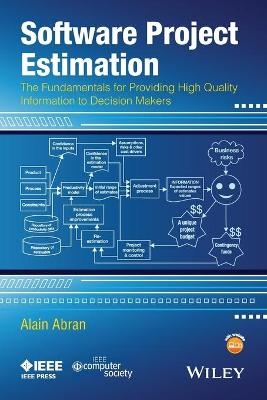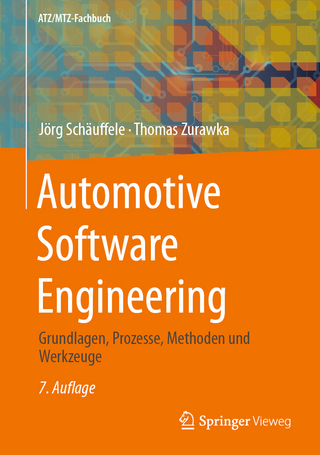
Software Project Estimation
John Wiley & Sons Inc (Verlag)
978-1-118-95408-9 (ISBN)
End-of-chapter exercises
Over 100 figures illustrating the concepts presented throughout the book
Examples incorporated with industry data
Alain Abran, PhD, is a Professor and the Director of the Software Engineering Research Laboratory at Université du Québec, Canada. He is also Co-Chair of the Common Software Measurement International Consortium. He was the international secretary for ISO/IEC JTC1 SC7. Dr. Abran has over 20 years of industry experience in information systems development and software engineering.
Foreword xiii
Overview xvii
Acknowledgments xxiii
About the Author xxv
Part One Understanding the Estimation Process 1
1. The Estimation Process: Phases and Roles 3
1.1. Introduction 3
1.2. Generic Approaches in Estimation Models: Judgment or Engineering? 4
1.2.1. Practitioner’s Approach: Judgment and Craftsmanship 4
1.2.2. Engineering Approach: Modest–One Variable at a Time 5
1.3. Overview of Software Project Estimation and Current Practices 6
1.3.1. Overview of an Estimation Process 6
1.3.2. Poor Estimation Practices 7
1.3.3. Examples of Poor Estimation Practices 9
1.3.4. The Reality: A Tally of Failures 10
1.4. Levels of Uncertainty in an Estimation Process 11
1.4.1. The Cone of Uncertainty 11
1.4.2. Uncertainty in a Productivity Model 12
1.5. Productivity Models 14
1.6. The Estimation Process 16
1.6.1. The Context of the Estimation Process 16
1.6.2. The Foundation: The Productivity Model 17
1.6.3. The Full Estimation Process 18
1.7. Budgeting and Estimating: Roles and Responsibilities 23
1.7.1. Project Budgeting: Levels of Responsibility 23
1.7.2. The Estimator 25
1.7.3. The Manager (Decision-Taker and Overseer) 25
1.8. Pricing Strategies 27
1.8.1. Customers-Suppliers: The Risk Transfer Game in Estimation 28
1.9. Summary – Estimating Process, Roles, and Responsibilities 28
Exercises 30
Term Assignments 31
2. Engineering and Economics Concepts for Understanding Software Process Performance 32
2.1. Introduction: The Production (Development) Process 32
2.2. The Engineering (and Management) Perspective on a Production Process 34
2.3. Simple Quantitative Process Models 36
2.3.1. Productivity Ratio 36
2.3.2. Unit Effort (or Unit Cost) Ratio 38
2.3.3. Averages 39
2.3.4. Linear and Non-Linear Models 42
2.4. Quantitative Models and Economics Concepts 45
2.4.1. Fixed and Variable Costs 45
2.4.2. Economies and Diseconomies of Scale 48
2.5. Software Engineering Datasets and Their Distribution 49
2.5.1. Wedge-Shaped Datasets 49
2.5.2. Homogeneous Datasets 50
2.6. Productivity Models: Explicit and Implicit Variables 52
2.7. A Single and Universal Catch-All Multidimensional Model or Multiple Simpler Models? 54
2.7.1. Models Built from Available Data 55
2.7.2. Models Built on Opinions on Cost Drivers 55
2.7.3. Multiple Models with Coexisting Economies and Diseconomies of Scale 56
Exercises 58
Term Assignments 59
3. Project Scenarios, Budgeting, and Contingency Planning 60
3.1. Introduction 60
3.2. Project Scenarios for Estimation Purposes 61
3.3. Probability of Underestimation and Contingency Funds 65
3.4. A Contingency Example for a Single Project 67
3.5. Managing Contingency Funds at the Portfolio Level 69
3.6. Managerial Prerogatives: An Example in the AGILE Context 69
3.7. Summary 71
Further Reading: A Simulation for Budgeting at the Portfolio Level 71
Exercises 74
Term Assignments 75
Part Two Estimation Process: What Must be Verified? 77
4. What Must be Verified in an Estimation Process: An Overview 79
4.1. Introduction 79
4.2. Verification of the Direct Inputs to An Estimation Process 81
4.2.1. Identification of the Estimation Inputs 81
4.2.2. Documenting the Quality of These Inputs 82
4.3. Verification of the Productivity Model 84
4.3.1. In-House Productivity Models 84
4.3.2. Externally Provided Models 85
4.4. Verification of the Adjustment Phase 86
4.5. Verification of the Budgeting Phase 87
4.6. Re-Estimation and Continuous Improvement to the Full Estimation Process 88
Further Reading: The Estimation Verification Report 89
Exercises 92
Term Assignments 93
5. Verification of the Dataset Used to Build the Models 94
5.1. Introduction 94
5.2. Verification of DIRECT Inputs 96
5.2.1. Verification of the Data Definitions and Data Quality 96
5.2.2. Importance of the Verification of the Measurement Scale Type 97
5.3. Graphical Analysis – One-Dimensional 100
5.4. Analysis of the Distribution of the Input Variables 102
5.4.1. Identification of a Normal (Gaussian) Distribution 102
5.4.2. Identification of Outliers: One-Dimensional Representation 103
5.4.3. Log Transformation 107
5.5. Graphical Analysis – Two-Dimensional 108
5.6. Size Inputs Derived from a Conversion Formula 111
5.7. Summary 112
Further Reading: Measurement and Quantification 113
Exercises 116
Term Assignments 117
Exercises–Further Reading Section 117
Term Assignments–Further Reading Section 118
6. Verification of Productivity Models 119
6.1. Introduction 119
6.2. Criteria Describing the Relationships Across Variables 120
6.2.1. Simple Criteria 120
6.2.2. Practical Interpretation of Criteria Values 122
6.2.3. More Advanced Criteria 124
6.3. Verification of the Assumptions of the Models 125
6.3.1. Three Key Conditions Often Required 125
6.3.2. Sample Size 126
6.4. Evaluation of Models by Their Own Builders 127
6.5. Models Already Built–Should You Trust Them? 128
6.5.1. Independent Evaluations: Small-Scale Replication Studies 128
6.5.2. Large-Scale Replication Studies 129
6.6. Lessons Learned: Distinct Models by Size Range 133
6.6.1. In Practice, Which is the Better Model? 138
6.7. Summary 138
Exercises 139
Term Assignments 139
7. Verification of the Adjustment Phase 141
7.1. Introduction 141
7.2. Adjustment Phase in the Estimation Process 142
7.2.1. Adjusting the Estimation Ranges 142
7.2.2. The Adjustment Phase in the Decision-Making Process: Identifying Scenarios for Managers 144
7.3. The Bundled Approach in Current Practices 145
7.3.1. Overall Approach 145
7.3.2. Detailed Approach for Combining the Impact of Multiple Cost Drivers in Current Models 146
7.3.3. Selecting and Categorizing Each Adjustment: The Transformation of Nominal Scale Cost Drivers into
Numbers 147
7.4. Cost Drivers as Estimation Submodels! 148
7.4.1. Cost Drivers as Step Functions 148
7.4.2. Step Function Estimation Submodels with Unknown Error Ranges 149
7.5. Uncertainty and Error Propagation 151
7.5.1. Error Propagation in Mathematical Formulas 151
7.5.2. The Relevance of Error Propagation in Models 153
Exercises 156
Term Assignments 157
Part Three Building Estimation Models: Data Collection and Analysis 159
8. Data Collection and Industry Standards: The ISBSG Repository 161
8.1. Introduction: Data Collection Requirements 161
8.2. The International Software Benchmarking Standards Group 163
8.2.1. The ISBSG Organization 163
8.2.2. The ISBSG Repository 164
8.3. ISBSG Data Collection Procedures 165
8.3.1. The Data Collection Questionnaire 165
8.3.2. ISBSG Data Definitions 167
8.4. Completed ISBSG Individual Project Benchmarking Reports: Some Examples 170
8.5. Preparing to Use the ISBSG Repository 173
8.5.1. ISBSG Data Extract 173
8.5.2. Data Preparation: Quality of the Data Collected 173
8.5.3. Missing Data: An Example with Effort Data 175
Further Reading 1: Benchmarking Types 177
Further Reading 2: Detailed Structure of the ISBSG Data Extract 179
Exercises 183
Term Assignments 183
9. Building and Evaluating Single Variable Models 185
9.1. Introduction 185
9.2. Modestly, One Variable at a Time 186
9.2.1. The Key Independent Variable: Software Size 186
9.2.2. Analysis of the Work–Effort Relationship in a Sample 188
9.3. Data Preparation 189
9.3.1. Descriptive Analysis 189
9.3.2. Identifying Relevant Samples and Outliers 189
9.4. Analysis of the Quality and Constraints of Models 193
9.4.1. Small Projects 195
9.4.2. Larger Projects 195
9.4.3. Implication for Practitioners 195
9.5. Other Models by Programming Language 196
9.6. Summary 202
Exercises 203
Term Assignments 203
10. Building Models with Categorical Variables 205
10.1. Introduction 205
10.2. The Available Dataset 206
10.3. Initial Model with a Single Independent Variable 208
10.3.1. Simple Linear Regression Model with Functional Size Only 208
10.3.2. Nonlinear Regression Models with Functional Size 208
10.4. Regression Models with Two Independent Variables 210
10.4.1. Multiple Regression Models with Two Independent Quantitative Variables 210
10.4.2. Multiple Regression Models with a Categorical Variable: Project Difficulty 210
10.4.3. The Interaction of Independent Variables 215
Exercises 216
Term Assignments 217
11. Contribution of Productivity Extremes in Estimation 218
11.1. Introduction 218
11.2. Identification of Productivity Extremes 219
11.3. Investigation of Productivity Extremes 220
11.3.1. Projects with Very Low Unit Effort 221
11.3.2. Projects with Very High Unit Effort 222
11.4. Lessons Learned for Estimation Purposes 224
Exercises 225
Term Assignments 225
12. Multiple Models from a Single Dataset 227
12.1. Introduction 227
12.2. Low and High Sensitivity to Functional Size Increases: Multiple Models 228
12.3. The Empirical Study 230
12.3.1. Context 230
12.3.2. Data Collection Procedures 231
12.3.3. Data Quality Controls 231
12.4. Descriptive Analysis 231
12.4.1. Project Characteristics 231
12.4.2. Documentation Quality and Its Impact on Functional Size Quality 233
12.4.3. Unit Effort (in Hours) 234
12.5. Productivity Analysis 234
12.5.1. Single Model with the Full Dataset 234
12.5.2. Model of the Least Productive Projects 235
12.5.3. Model of the Most Productive Projects 237
12.6. External Benchmarking with the ISBSG Repository 238
12.6.1. Project Selection Criteria and Samples 238
12.6.2. External Benchmarking Analysis 239
12.6.3. Further Considerations 240
12.7. Identification of the Adjustment Factors for Model Selection 241
12.7.1. Projects with the Highest Productivity (i.e., the Lowest Unit Effort) 241
12.7.2. Lessons Learned 242
Exercises 243
Term Assignments 243
13. Re-Estimation: A Recovery Effort Model 244
13.1. Introduction 244
13.2. The Need for Re-Estimation and Related Issues 245
13.3. The Recovery Effort Model 246
13.3.1. Key Concepts 246
13.3.2. Ramp-Up Process Losses 247
13.4. A Recovery Model When a Re-Estimation Need is Recognized at Time T > 0 248
13.4.1. Summary of Recovery Variables 248
13.4.2. A Mathematical Model of a Recovery Course in Re-Estimation 248
13.4.3. Probability of Underestimation −p(u) 249
13.4.4. Probability of Acknowledging the Underestimation on a Given Month −p(t) 250
Exercises 251
Term Assignments 251
References 253
Index 257
| Verlagsort | New York |
|---|---|
| Sprache | englisch |
| Maße | 155 x 236 mm |
| Gewicht | 408 g |
| Themenwelt | Mathematik / Informatik ► Informatik ► Software Entwicklung |
| Technik ► Elektrotechnik / Energietechnik | |
| ISBN-10 | 1-118-95408-4 / 1118954084 |
| ISBN-13 | 978-1-118-95408-9 / 9781118954089 |
| Zustand | Neuware |
| Haben Sie eine Frage zum Produkt? |
aus dem Bereich


